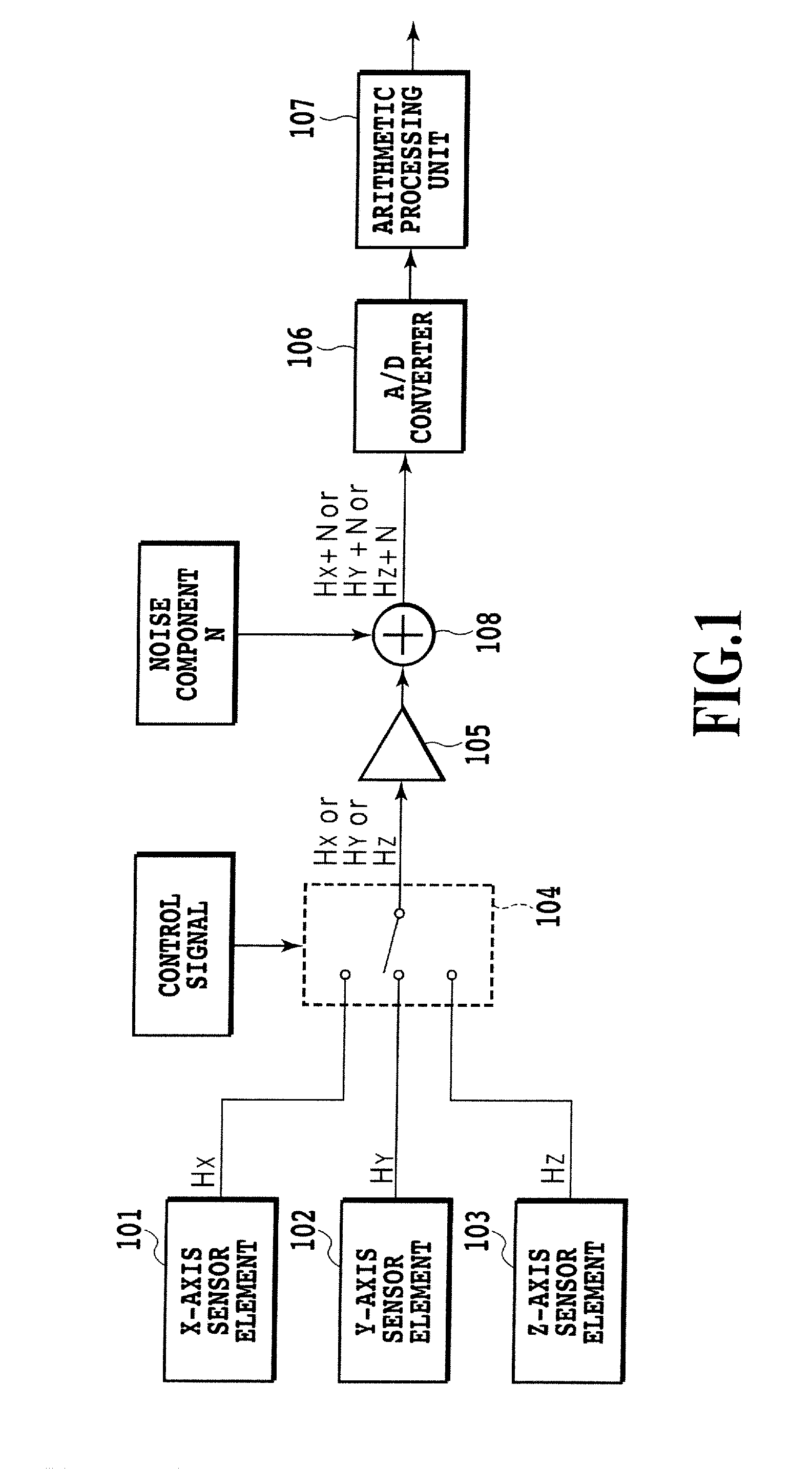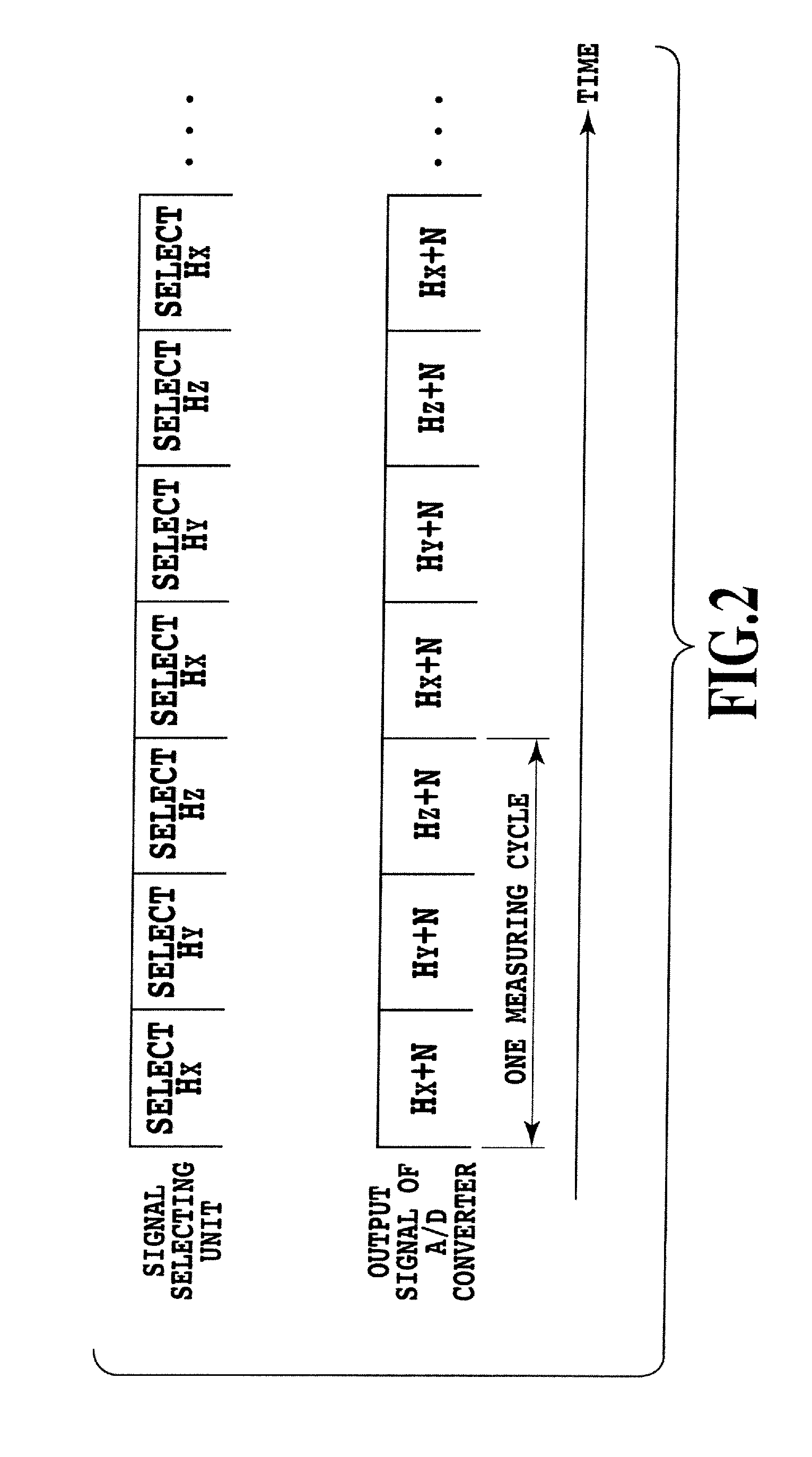Physical quantity measuring instrument and signal processing method thereof
a physical quantity and measurement instrument technology, applied in instruments, galvano-magnetic hall-effect devices, data acquisition and logging, etc., can solve the problems of increasing the noise component against the signal on the other side, the noise of portable equipment is susceptible to the noise of the other elements, and the sensor is miniaturized, so as to reduce the noise component and improve the reliability without increasing the size or cost of the circui
- Summary
- Abstract
- Description
- Claims
- Application Information
AI Technical Summary
Benefits of technology
Problems solved by technology
Method used
Image
Examples
embodiment 1
[0100]FIG. 7 is a block diagram showing a schematic configuration of a three-axis acceleration sensor, which is an embodiment 1 of the physical quantity measuring instrument in accordance with the present invention. Here, an X-axis sensor element 111, a Y-axis sensor element 112 and a Z-axis sensor element 113 correspond to the physical quantity detecting unit 11 in FIG. 6; a signal selecting unit 114, an operational amplifier 115 and an A / D converter 116 correspond to the signal processing unit 12 in FIG. 6; and an arithmetic processing unit 117 corresponds to the arithmetic processing unit 13 in FIG. 6. In addition, the reference numeral 118 designates a noise component added to the signal schematically.
[0101]As the acceleration sensor elements, Piezo-resistive sensors are suitable. However, any elements such as electrostatic capacitance sensors, piezoelectric sensors and thermal distribution detecting sensors can be used as long as they can detect acceleration.
[0102]In addition, ...
embodiment 2
[0118]FIG. 9 is a block diagram showing a schematic configuration of a magnetic sensor which is an embodiment 2 of the physical quantity measuring instrument in accordance with the present invention. FIG. 13A and FIG. 13B show a configuration example of the detecting unit of the embodiment 2 in accordance with the present invention, which has the same configuration as that of the Patent Document 2. Because of the effect of the magnetic concentrator, the sensor elements 211 and 212 can detect not only the signal based on the Z-axis component of the magnetic field, but also the signal based on the X-axis component; and the sensor elements 213 and 214 can detect not only the signal based on the Z-axis component of the magnetic field, but also the signal based on the Y-axis component simultaneously.
[0119]The magnetic concentrator consists of a ferromagnetic material, a material having a high relative permeability. In addition, the sensor elements 211-214, which have sensitivity to the m...
embodiment 3
[0143]FIG. 14A, FIG. 14B and FIG. 14C are diagrams for explaining an embodiment 3 of the physical quantity measuring instrument in accordance with the present invention: FIG. 14A is a schematic diagram of a configuration example of the detecting unit; FIG. 14B is a projection of a configuration example B of the detecting unit onto the X-Y plane; and FIG. 14C is a projection of a configuration example C of the detecting unit onto the X-Z plane.
[0144]The configuration example B shown in FIG. 14B has the sensor elements 211-214 disposed over the X-Y plane and inclined in the Z-axis direction each at an angle θ with respect to the X-Y plane.
[0145]Unless the sensor elements 211-214 have inclination in the Z-axis direction, they detect only the components corresponding to the axes along which they are disposed such as the sensor elements 211 and 212 detect the signal based on the X-axis component of the magnetic field, and the sensor elements 213 and 214 detect the signal based on the Y-a...
PUM
 Login to View More
Login to View More Abstract
Description
Claims
Application Information
 Login to View More
Login to View More - R&D
- Intellectual Property
- Life Sciences
- Materials
- Tech Scout
- Unparalleled Data Quality
- Higher Quality Content
- 60% Fewer Hallucinations
Browse by: Latest US Patents, China's latest patents, Technical Efficacy Thesaurus, Application Domain, Technology Topic, Popular Technical Reports.
© 2025 PatSnap. All rights reserved.Legal|Privacy policy|Modern Slavery Act Transparency Statement|Sitemap|About US| Contact US: help@patsnap.com



